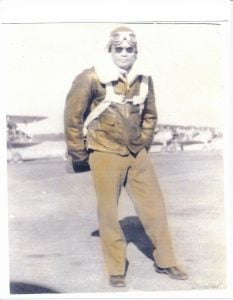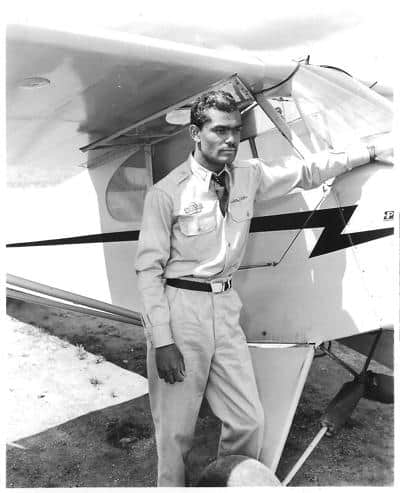
Frank Macon in a flight suit during primary training at Tuskegee.
Frank Macon
1923 – November 22, 2020
Frank Macon applied to the Civilian Air Patrol while still in high school and soloed from the airfield that is now the Air Force Academy. Soon, he was headed to join the 99th; in fact, Frank may have been the only pilot accepted to Tuskegee twice, having been sent home the first time for lying about his age.
Macon trained with Tuskegee’s Class 45A, but an incident during flight training left him with ruptured eardrums that took almost a year to heal. He was unable to fight in World War II due to the injury and long recovery.
He was in the final weeks before graduation and looking forward to service overseas, his officer’s uniform tailored and hanging in the closet, when — despite a “terrible” head cold — he went up to train on that fateful day 75 years ago.
“We were up there having a blast. We loved practicing our dogfighting,” says Macon, in “I Wanted to be a Pilot,” his 2019 autobiography aimed at young readers. “Looking back, I should have gone to the dispensary. That’s the doctor. Being stubborn, I didn’t.”
As he pulled his T-6 out of a power-dive, Macon felt an excruciating “pop.” The drastic pressure change of the maneuver had ruptured both his eardrums. He missed graduation and spent almost a year recovering. By the time he’d healed, World War II was over.
“When my class graduated, I was in the hospital,” he said. “I’ve thought about a lot of that … and it just seems like fate.”
Like he was meant to do something else
Lots of somethings else, as it turned out.
Macon earned his wings and returned to the Springs, where he worked for 23 years at Fort Carson, retiring as head of aircraft maintenance. He raised a family, ran a machine shop fabricating electronics, researched aviation accidents professionally, and continues to write, study, invent and work with kids to inspire a love of learning and curiosity.
“I really did things that I wouldn’t have done if I had just been a pilot because that’s all I would have been doing, boring holes in the sky,” said Macon.
You don’t have to be in a plane to bore holes in the sky and you don’t have to be a fighter pilot to pursue — and achieve — your dreams.
“There are a lot of kids who say, well, ‘They won’t let me do this.’ No. You’re the one that won’t let you do it,” he said. “I had to overcome a lot of obstacles to get to where I was, but for every obstacle I had to overcome I learned something.”
Like an airplane, Macon was built to soar. We all are, is his point.
Macon built his first “plane” out of orange crates when he was “eight or 10,” and hauled it down the street for a test run in the Uintah Gardens area.
That “was kind of a low area, kind of a swamp … and there was a hill and guys would try to drive their cars up there … to see how far they could get. Sometimes they’d roll down the hill,” Macon said. “We took it up there and was trying to fly it off, and the wings fell off.”
By the time he was a teen, Macon had found more productive channels for his creative energy.
The Alexander Film Co., which produced advertising shorts for movies, sat on a 26-acre compound that contained its own airstrip and airplane manufacturing plant that, at the time, was the largest of its kind in the world.
“Alexander Aircraft was up in the north end of town and I used to always ride my bicycle up there all the time and go in the factory when they were building the airplanes and watch what they did. And they showed me a lot … taught me a lot before I even got into the air,” Macon said. “Some would take me up flying, and I’d help wash the airplanes down or clean parts and things like that, so I just liked it. And so, it was just a part of me.”
Macon spent the rest of his free time at the garage down the street, watching the mechanics work. Eventually, the owner “got tired of running me off and he put me to work, sweeping the floor, cleaning the parts and all like that,” he said. “Finally, they started showing me how to disassemble different parts and also how to reassemble them.”
By the time Macon got to Tuskegee, not only could he fly an airplane, he could take it apart and put it back together again.
When asked who he considered to be the best leaders at Tuskegee. He paused for a long time and then said, ‘I can’t answer that. We all had to be exceptional. If everybody wasn’t exceptional in this experiment, it wouldn’t have happened.”
The first plane Macon built fell apart before it got into the air.
The last, a 1944 Stinson Vultee V-77 “Gullwing” aircraft, has a much more indelible story.

Frank Macon with his “beloved” 1944 Stinson.
Macon and some buddies were flying in the Denver area in the early 1950s when they spotted the plane sitting in an old airfield. They landed and inquired
about the vintage aircraft, and learned it had been made in America for the Canadian Air Force, and was a military plane used as a civilian transport during World War II.
“They wanted $1,500 for it and we said we’ll just give you $500, and they said, ‘We’ll take it,’” said Macon. “We took the wings off of it and put the tail section up in the pickup, put the wings on a trailer, and hauled it down to Colorado Springs.
And it took Macon and his partners over three years, working on evenings and weekends, to rebuild it.
On Veterans Day in 2019 Macon donated his prized 1944 Stinson Vultee V-77 “Gullwing” aircraft to the National Museum of World War II Aviation in Colorado Springs.
Notable quote
“There’s a zillion people on the face of the earth and every last one of them is different. It’s just the way we were made. Everybody has some little niche that they’re good at and can do. And if we put that to work, we can really accomplish a lot of things. There’s no place where one group of people are better than another group. Just do your best. Even when times get hard, you just keep going.” —from a 2019 interview for 176th Wing.
Sources:
ColoSPgs
The Gazette
Legacy.com





